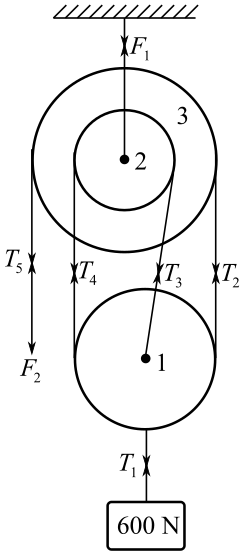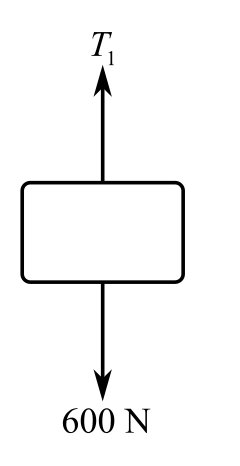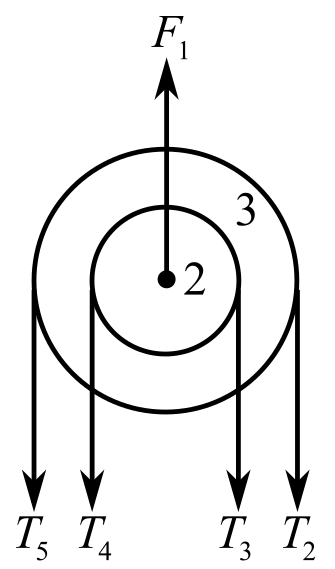
Concept explainers
(a) A 600-N load hangs motionlessly in Fig. 4-8. Assume the ropes to all be vertical and the pulleys to be weightless and frictionless. (a) What is the tension in the bottom hook attached, via a ring, to the load? (b) How many lengths of rope support the movable pulley? (c) What is the tension in the long rope? (d) How much force does the man apply? (e) How much force acts downward on the ceiling?
(a)
The magnitude of the tension in the bottom hook that is attached by a ring to the load in the Figure
Answer to Problem 17SP
Solution:
Explanation of Solution
Given data:
Refer to the figure 4-8.
Theload hanging motionlessly is
Formula used:
Write the expression for the first condition of the force’s equilibrium:
Here,
Explanation:
Consider all pulleys and hook as a system and draw its free body diagram:

In the above diagram,
Here, pulley
Since thesame long rope is passing over the pulley
Draw the free body diagram of the bottom hook, which is attached via a ring to the load.

In above the diagram,
Recall the expression for the first condition of the force’s equilibrium:
Consider the direction of the upward forces is positive and the direction of the downward forces is negative. Therefore,
Substitute
Conclusion:
The magnitude of the tension attached in a bottom hook is
(b)
The number of sections of the rope that supports the movable pulleyin the Figure
Answer to Problem 17SP
Solution:
Explanation of Solution
Given data:
Refer to the figure 4-8.
The load hanging at rest is
Formula used:
Write the expression for the first condition of the force’s equilibrium:
Here,
Explanation:
Refer the schematic diagram from the first part (a).
To observed the free body diagram, there are only three ropes that support the movable pulley.
Conclusion:
A segment of the rope that supports the movable pulley is
(c)
The magnitude of the tension in the long ropein the Figure
Answer to Problem 17SP
Solution:
Explanation of Solution
Given data:
Refer to the figure 4-8.
The load hanging at rest is
Formula used:
Write the expression for the first condition of the force’s equilibrium:
Here,
Explanation:
Draw the free body diagram of the pulley

In the above diagram,
Recall the expression for the first condition of the force’s equilibrium:
Consider the direction of the upward forces is positive and the direction of the downward forces is negative. Therefore,
Refer to the equation (1)
Substitute
Conclusion:
The magnitude of the tension in the long rope is
(d)
The maximum force applied by the man to pull the rope in the Figure
Answer to Problem 17SP
Solution:
Explanation of Solution
Given data:
Refer to the figure 4-8.
The load hanging motionlessly is
Formula used:
Write the expression for the first condition of the force’s equilibrium:
Here,
Explanation:
Draw the free body diagram when a man applied a pulling force on the rope:

To observed the above diagram,
Recall the expression for the first condition of the force’s equilibrium:
Consider the direction of the upward forces is positive and the direction of the downward forces is negative. Therefore,
Since the same rope is passing over the pulley, the tension
Substitute
Conclusion:
The magnitude of the force applied by the man is
(e)
The maximum force that is acting downward on the ceilingin the Figure 4.8.
Answer to Problem 17SP
Solution:
Explanation of Solution
Given data:
Refer to the figure 4-8.
The load hanging motionlessly is
Formula used:
Write the expression for the first condition of the force’s equilibrium:
Here,
Explanation:
Consider both the pulley 3 and pulley 3 as a system and draw theirfree body diagram:

In the above diagram,
Recall the expression for the first condition of the force’s equilibrium:
Consider the direction of the upward forces is positive and the direction of the downward forces is negative. Therefore,
Refer to the equation (1)
Substitute
Since
Conclusion:
The maximum force acting on the ceiling is
Want to see more full solutions like this?
Chapter 4 Solutions
Schaum's Outline of College Physics, Twelfth Edition (Schaum's Outlines)
- A woman pulls a sled which, together with its load, has a mass of m kg. Let g be the acceleration due to gravity. If her arm makes an angle of theta with her body (assumed vertical) and the coefficient of friction (a positive constant) is mu, the least force, F, she must exert to move the sled is given byarrow_forwardThe weight compound towards the inclined surface of a body of mass (5.6 kg) on a surface inclined at an angle of (18) is equal toarrow_forwardWhich is greater? Which has a greater horizontal component, a 100-N force directed at an angle of 60° above the horizontal or a 60-N force directed at an angle of 30° above the horizontal?arrow_forward
- If The Net Force Acting On A Body Be Zero, Then Will The Body Remain Necessarily In Rest Position?arrow_forwardA body of weight 450 N is pulled up an inclined plane by a force of 300N . The inclination of the plane is 30° to the horizontal and the force is applied parallel to the plane. Determine the coefficient of frictionarrow_forwardA boxweighing 150 lb is moved across a horizontal floor by dragging it means of a rope attached to the front end. If the rope makesan angle of 30 ̊with the floor and if the coefficient of friction between box and floor is 0.4, find the force exerted by the man pulling the rope.arrow_forward
- For the woman being pulled forward on the toboggan in Figure 4.33, is the magnitude of the normal force exerted by the ground on the toboggan (a) equal to the total weight of the woman plus the toboggan, (b) greater than the total weight, (c) less than the total weight, or (d) possibly greater than or less than the total weight, depending on the size of the weight relative to the tension in the rope?arrow_forwardIf the acceleration of an object is zero, are no forces actingon it? Explainarrow_forwardIf the acceleration of an object is zero,are no forces actingon it? Explain.arrow_forward
 University Physics Volume 1PhysicsISBN:9781938168277Author:William Moebs, Samuel J. Ling, Jeff SannyPublisher:OpenStax - Rice University
University Physics Volume 1PhysicsISBN:9781938168277Author:William Moebs, Samuel J. Ling, Jeff SannyPublisher:OpenStax - Rice University College PhysicsPhysicsISBN:9781305952300Author:Raymond A. Serway, Chris VuillePublisher:Cengage Learning
College PhysicsPhysicsISBN:9781305952300Author:Raymond A. Serway, Chris VuillePublisher:Cengage Learning College PhysicsPhysicsISBN:9781285737027Author:Raymond A. Serway, Chris VuillePublisher:Cengage Learning
College PhysicsPhysicsISBN:9781285737027Author:Raymond A. Serway, Chris VuillePublisher:Cengage Learning


